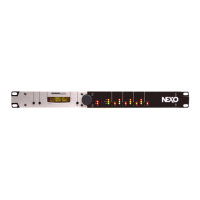PAGE 22/24
SOME WORDS ON AMPLIFIERS
USER MANUAL LOAD1_80
DATE: 30/08/00 12:48
Some words on Amplifiers
Power
NEXO recommends high power amplifiers in all cases. Budget constraints are the only reason to
select lower power amplifiers. If an incident occurs on an installation without protection the fact that
amps only generating half their rated output power (-3dB) are used will not change anything in
respect of possible damage. This is due to the fact that the RMS power handling of the weakest
component in the system is always 6 to 10 dB lower than the amps' ratings.
Current rating
It is very important that the amplifier behaves correctly under low load conditions. A speaker system
is reactive by nature, on transient signals like music it will require much higher instantaneous
current than its nominal impedance would indicate (four to ten times more). Amplifiers are always
specified by continuous RMS power into resistive loads (which is irrelevant); the only useful
information in that respect is the specification into a 2 ohms load. It is possible to make an amplifier
listening test by loading them with twice the number of cabinets considered for the application (2
speakers per channel instead of one, 4 instead of 2…) and modulating at high level (onset of
clipping). If the signal does not noticeably deteriorate the amplifier is well adapted (overheating after
approximately ten minutes is normal but thermal protection must not operate too quickly after
starting this test).
Amplifier gains
As you already read in the Quick Start section Information on the amplifiers used is MANDATORY.
This value is the key of a correct setting. It is very important to know the gain of all amplifiers
present in your set-up. The tolerance shall be about ±0,5 dB. In practice this can be difficult to
achieve:
• Some amplifier brands have an identical input sensitivity for models of different power rating (this
means DIFFERENT GAIN for each model). This problematic practice, inherited from non-professional
applications, is easily detected when the manufacturer specifies the same input sensitivity for all its
range (like 775mV/0dBm or 1.55V/+6dBm). This translates to very high gain values on higher power
models.
• Other brands do offer constant gain but only within a given product range (like higher gain on all semi-
professional amps).
• Even if a manufacturer is conscious of this problem and applies the constant gain rule to all its models,
the value he chooses is not necessarily the same as other manufacturers.
• Some manufacturers can deliver products where manufacturing tolerance on the same model is ±1dB
or more. Worse, he can agree to modify this gain at the customer’s request without clear and visible
identification on the device. Some amps feature internal gain switches and it is sometimes impossible
to know the amp gain without measuring or opening it.

